
Project Gutenberg's Old Fort Garland, by James T. Forrest and Rosamund Slack
This eBook is for the use of anyone anywhere in the United States and most
other parts of the world at no cost and with almost no restrictions
whatsoever. You may copy it, give it away or re-use it under the terms of
the Project Gutenberg License included with this eBook or online at
www.gutenberg.org. If you are not located in the United States, you'll have
to check the laws of the country where you are located before using this ebook.
Title: Old Fort Garland
Author: James T. Forrest
Rosamund Slack
Illustrator: Paul Rossi
Release Date: November 29, 2014 [EBook #47492]
Language: English
Character set encoding: UTF-8
*** START OF THIS PROJECT GUTENBERG EBOOK OLD FORT GARLAND ***
Produced by Stephen Hutcheson, Dave Morgan and the Online
Distributed Proofreading Team at http://www.pgdp.net

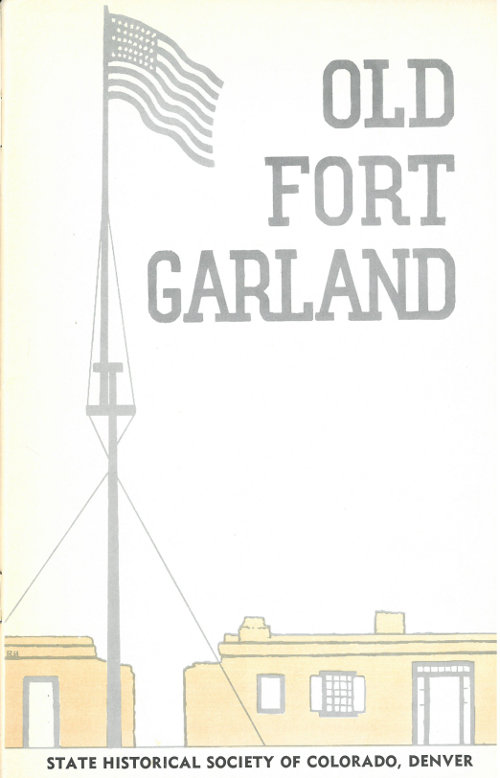

IN MEMORY
OF
EDGAR C. McMECHEN
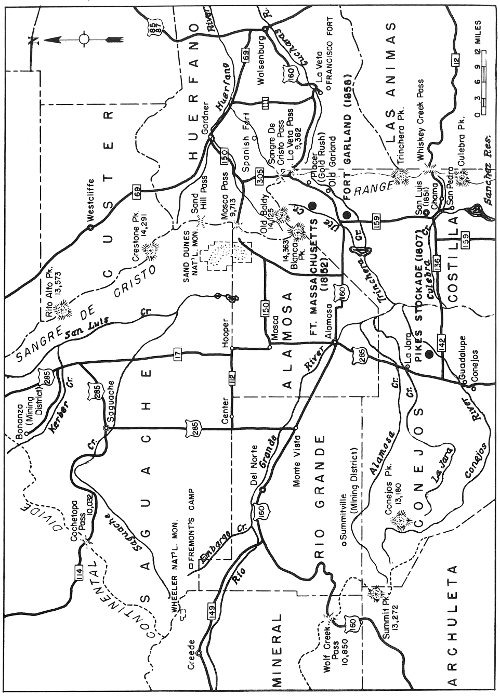
[This map in higher resolution]
Copyright, 1954, by
State Historical Society
of Colorado
Denver, Colorado
All Rights Reserved
Artwork for this booklet by Paul Rossi
By James T. Forrest
(Author’s note: This is a brief history of Fort Garland, Colorado, as it might have been told by a soldier present during most of the fort’s active years. The soldier and his journal never existed, but the facts contained in the journal are basically true. The information in this story is a product of research through most of the available documents concerning Fort Garland. In places, fiction has been introduced to give the journal color, but all important events or facts occurred as described.) J.T.F.
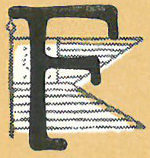
Fort Garland, July 29th, 1860. Arrived here yesterday with my company, Company F of the U. S. 10th Infantry. Our outfit just limped in from a 640 mile march from Camp Floyd, Utah Territory. Took us most a month. Our commander’s name is Major (E.R.S.) Canby. It’s good to bunk down some place indoors for a change and to wash some of the dust out of my throat and off my trail-weary feet. Too tired to look around new post today.
Fort Garland, August 10th, 1860. Getting settled. Guess my company will be here awhile. Major Canby and Company A left a few days ago to quiet some outlaw Indians (Navajos) somewhere southwest of here. Companies F and H of the 10th remained.
Looked into the past of this fort. Named for Brevet Brigadier General John Garland, commanding the Department of New Mexico. It was built in 1858 by Captain Tom Duncan and his Mounted Riflemen, with a company (Company A) of the 3rd Infantry. Seems Fort Massachusetts, north of here some six miles, was built in 1852 to protect this area from the Indians. After a few years on this frontier with bands of Ute Indians all around they decided the old fort was too close under the mountains to be safe against surprise attack, so the command was moved down here on the open plain. Guess if the wind doesn’t blow us all away, the post will stick it out here until the last Indian is dead or put off somewhere on the desert to eat sand and yucca.
September 12, 1860. Got a promotion today. We all fell out for first call at 5 a.m. and lined up to be read off. 2 “Here,” we called out, hardly more’n awake. “All present or accounted for,” said the sergeant to the Lieutenant, “All except those on wood pile or water detail in Company F will fall out for company drill immediately after morning mess.” The sergeant paused and looked down the line until he spotted me. “Special order,” he continued. “Private O’Connor, Timothy, will report to the orderly room to serve as chief clerk. O’Connor!” “Yo,” I answered. “O’Connor, you’re now a corporal. Get those stripes sewed on.”
September 14, 1860. Discovered why I was made clerk. Seems I’m one of the few in my company who can write so’s anybody can read what’s been writ. That schooling back in Indiana might have been some good after all. Thing about being clerk is that I get to know most of what’s going to happen afore it happens. Company H clerk told me yesterday that he put himself in for a promotion last week.
The post is getting to seem like home to most of us by now. Pretty fair place. The buildings are made of mud, or what people around here call adobe. The adobes are made of brown clay and baked in the sun, then stuck together with the same mud after they’re baked hard. The two barracks face the parade ground from the east and from the west. They are both about 119 feet long and 33 feet wide; the roofs are nearly flat, with a slight slope toward the parade. The inside of each barrack is divided into several rooms, including: company office, store room, two squad-rooms and a kitchen. The latter is used also for mess. The walls are the same adobe, white-washed. Each barrack was built to house one company. The squad rooms are heated by open fireplaces—looks like we’ll freeze come winter, except when we’re backed up to the fire burning our pants.
The officer’s quarters are also of adobe, as is everything around these parts, and are built along the north end of the parade. There are quarters for seven officers and their families, but a man’d have to be pretty brave to bring his family out here. The officer’s rooms are ceiled with boards and plastered with mud, then whitewashed. Even have board floor in these quarters, with bear skin and Indian blankets scattered here and there. Some of the quarters have furniture brought from the East, but most of the things are like the benches and tables and bunks we soldiers have—made right here at the fort of cottonwood or pine.
On the south end of the parade are two long buildings used for offices and store rooms. The guard house is in one of these two, but I don’t care to learn of the interior of that place. I’m told that it’s poorly ventilated, having no windows. In winter there’s no heat in the cells. The guards have a fireplace in their area, but the men in the cells have to wear their blankets like Indians from morning ’til night to keep warm. At night there’s no sleeping, it’s that cold. Not many men getting in trouble during the cold months, I’m told.
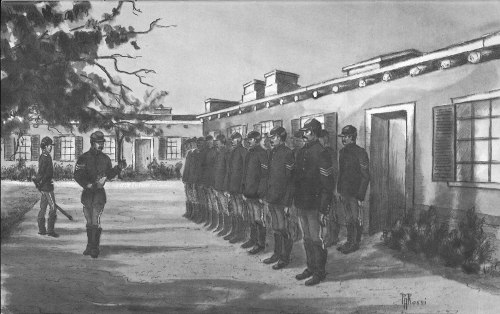
Evening Muster. Cavalry troop in formation.
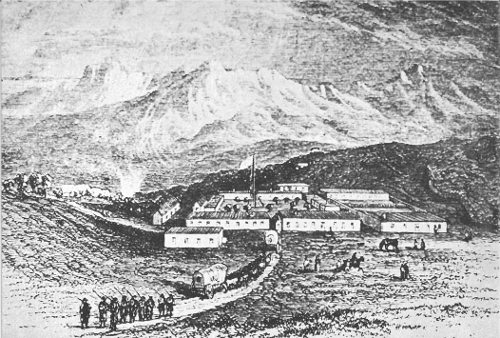
Old Fort Garland
From an early drawing in Harper’s New Monthly.
The stables are located some 120 paces due east of the east barrack and are strong smelling quarters, consisting of three long corrals built of the same old adobe. The corrals contain sheds for the common horses and enclosed stables for the officers’ mounts.
The post gets its water from the Ute Creek and water from this stream flows in a ditch completely around the parade. The water is cold and fresh the entire year, maybe because it comes from the snows of Mount Blanca to the north.
The post has a garden of about six acres, in which all of us must take a tour of duty. In this plot the men try to grow about everything, but only those vegetables or grains which will ripen or mature in our short season are successful.
I discovered only today that this fort is on a reservation covering about six square miles, with the post buildings smack in the center. Back in Indiana that would be a considerable piece of land, but out here that’s no more’n enough to feed one good-sized jack rabbit.
December 26, 1860. Christmas come and gone for another year. I’ve never seen such a feast as we had here yesterday. 5 The weather was tough outside, with wind and snow, but inside there was nothing but cheer. The dinner consisted of every kind of meat that can be had in this part of the Territory. We had smoked bear, roast deer, elk and antelope; we had trout, wild duck, and every breed of bird that walks or flys within fifty miles of this place. One of the favorite pastimes of men at our post is hunting—everything from bear to wild cats and coyotes. Our Indian friends tell us we’re driving off the game, but that seems unlikely, at least not for the next hundred years. Christmas was not all eating; those who didn’t get sick from eating too much got into even worse shape from too much whiskey. We all figured we might as well celebrate, seeing that we’re soon to have a new president, Abe Lincoln. Some say that the South is so opposed to Abe and the North in general that they’ll pack up and leave the Union. Some say they won’t. I figure we got enough troubles out here just trying to keep these Indians from running loose.
May 3, 1861. Whole series of Indian uprisings in Territory. A number of chiefs, including Chief Uray[1] of the Tabequache Utes, stopped off here to pow wow with our commander. Indians not happy with rations issued by Indian Agent at Conejos. A band of them left here and marched toward Denver City.
June 1, 1861. Word just reached Garland that Lincoln has called for 75,000 volunteers to serve three months until trouble with the South can be settled. Southerners here say it won’t be over that soon, unless the South wins. Some of the boys from the Southern States have deserted—struck out for Texas.
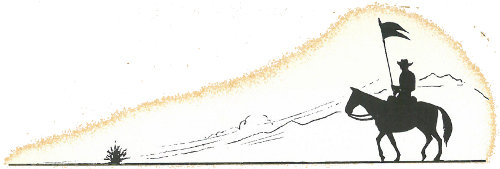
August 4, 1861. Back East it seems the North and South had a big battle at a place called “Bull Run.” Most of the two outfits here at Garland are preparing to leave for New Mexico, some say Fort Craig. We’ve been getting squad and company drill every day since the war started. Last month we had 6 two sham battles. Seems us Indian fighters have got to learn all over again how to fight Rebs. All the non-coms and the officers have been staying up nights studying Hardee’s Tactics and the book of Army Regulations. Somehow or other I got promoted to sergeant.
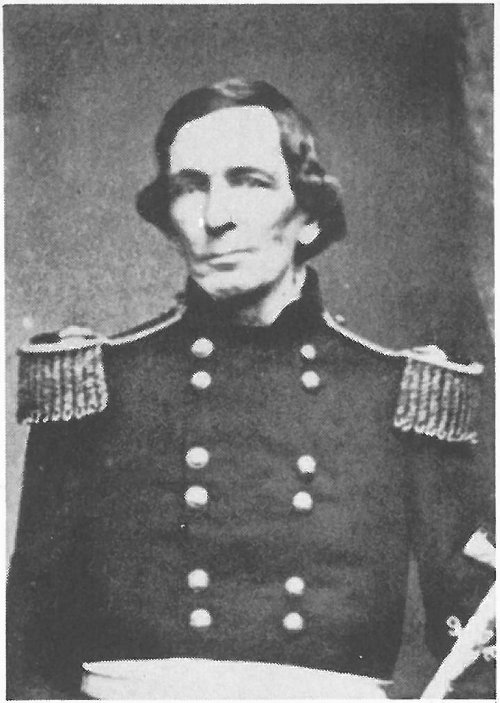
John Garland
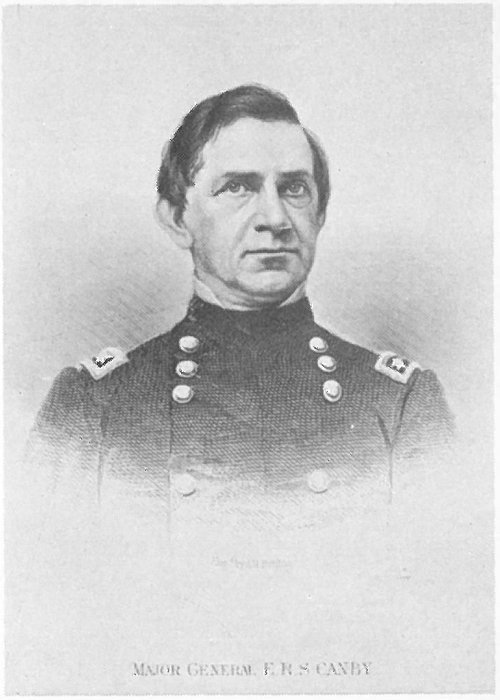
Major General E. R. S. Canby
October 20, 1861. Most of F and H Companies have left for Fort Craig to join Major Canby. Re-enforcements, in the form of volunteers, are expected soon. The old soldiers left here don’t think much of the idea of fighting with a bunch of recruits, but Governor Gilpin is looking under every stone for troops. Most of Colorado’s too busy looking for gold to worry about the war.

December 29, 1861. Captain (T. R.) Dodd and Captain (J. H.) Ford arrived with troops this month. Dodd’s company left Canon City on December 7th and marched to Fort Garland by way of the Sangre de Cristo Pass. His company was provisionally designated Company A of the Second Colorado Infantry. Ford’s group came struggling into camp on December 21st, having also marched from Canon City. This latter unit was provisionally designated Company B of the Second Colorado Infantry. Captain Dodd and his “foot Volunteers” didn’t stay long, moving on to Santa Fe, eventually bound for Fort Craig. Rumor has come north that a Major (H. H.) Sibley, late of the United States Army, has come out to New Mexico to win that territory for the South. He’s got quite a crew assembled at Fort Bliss; the last report listed “Sibley’s Brigade” at over 3000 strong. There’s not that many fighting men in the whole Colorado Territory!
The volunteers are roosting around this fort like chickens. And sad birds they are too. There’s not a complete uniform in the whole lot and not a man knows his right foot from his left. But they don’t complain—and that’s something for soldiers, citizen or old army. The other evening Company A had their men on guard duty around the buildings and in one cold and windy spot the guard had on an old grey overcoat. The overcoat was the only one the company had and every night it was given to the guard at this post. The company commander was making his rounds as usual when he spotted the familiar coat. He turned to his orderly and said, “Sergeant Ford, is the same man in that same d—— coat always on guard here?” “No, be jabers,” said Pat Ford, “but the same coat kivers the whole company now.”[2]
March 17, 1862. Word received here that Garland is to be destroyed if it is menaced by the enemy. Fort Union is to be defended at all cost. Another detachment moves out of here tomorrow. I have asked to go. The big battle seems to be shaping up in the south. Canby has been made a colonel.
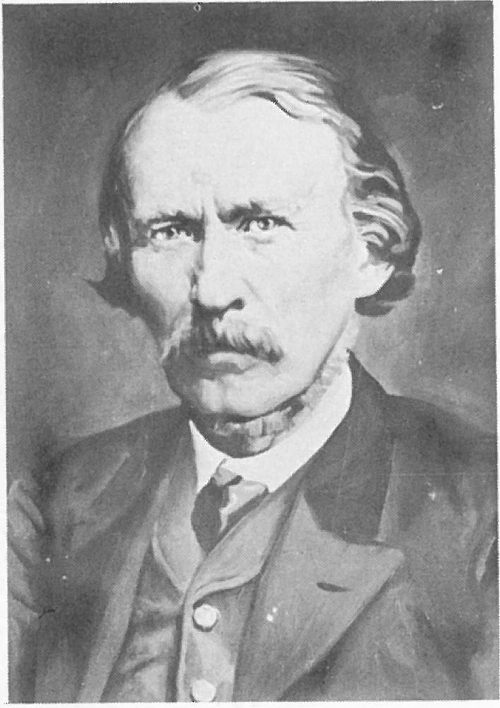
Kit Carson
Painting by Waldo Love.
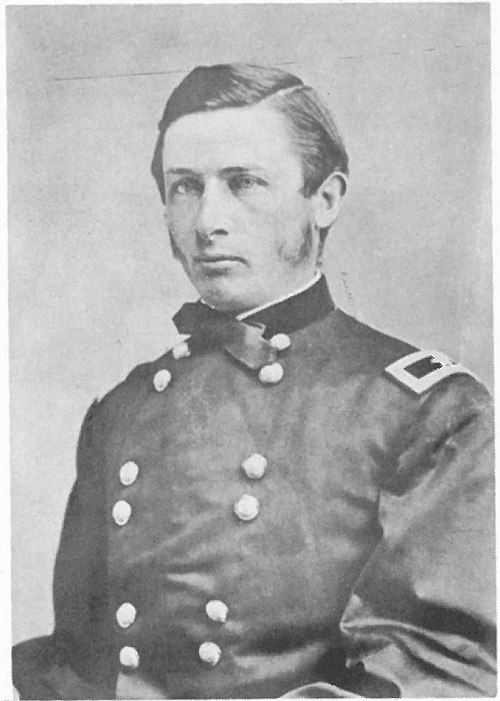
Ronald S. Mackenzie
La Glorieta Pass, New Mexico, March 27, 1862. Arrived here about time shooting was over. The Rebs have been turned back, some 280 killed in two battles here. Our side was luckier. The heroes of this battle are many, but Major (J. M.) Chivington and the Colorado Volunteers deserve a big chunk of the credit. I guess we start the long march back, now 8 that Sibley’s on the run.
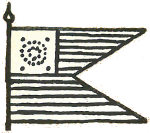
Fort Garland, October 5, 1862. Was sent with a small detachment back to Garland. Fort about the same. Commander now is Colonel Sam Tappan. Pretty good man. More people coming into the San Luis Valley every day. Either they’re looking for gold or they’re getting away from the war—maybe both.
September 2, 1863. Been some nasty killings going on around here and not by Indians either. Two brothers, Felie Nerio and Vivian Espinosa, from San Rafael, a little town at the edge of the mountains, have sworn to kill every American they meet. Been doing a pretty good job too, so far. Seems they even tried to kill Governor (John) Evans when he was down this way. Didn’t kill the Governor but killed two others. The Governor had offered a reward for these two and they didn’t like the thought of having their heads turned in for gold, I guess. Like to collect that reward myself. Reports are that the Espinosas have killed near thirty people in the valley during the past few months.
September 11, 1863. Tom Tobin did it. I guess Tobin had heard enough about the Espinosas, so when Colonel Tappan asked him if he’d head a party to go find the murderers and bring them in, he accepted. Tobin and Lieutenant Baldwin and fifteen soldiers from the fort set out on September 7th. Tobin trailed Espinosa like he’d trail a deer or an Indian and after several days found him along La Veta Creek. Espinosa was with his cousin and fellow maniac in thick brush when Tobin came on them. Tobin fired and wounded one, while three soldiers fired at once and brought down the other. Tobin then beheaded the two and took the heads to Colonel Tappan. He rolled the heads from the sack and said, “Here Colonel, I have accomplished what you wished. This head is Espinosa’s. This other is his companion’s head and there’s no mistake made.”[3] Since the other Espinosa brother was killed some weeks ago, I guess that ends that little fracas. Tobin didn’t even know about the reward, he says. Some of the local citizens are thinking of giving Tom a Hawkins rifle, like he’s wanted 9 for a long time now, in appreciation for what he’s done.
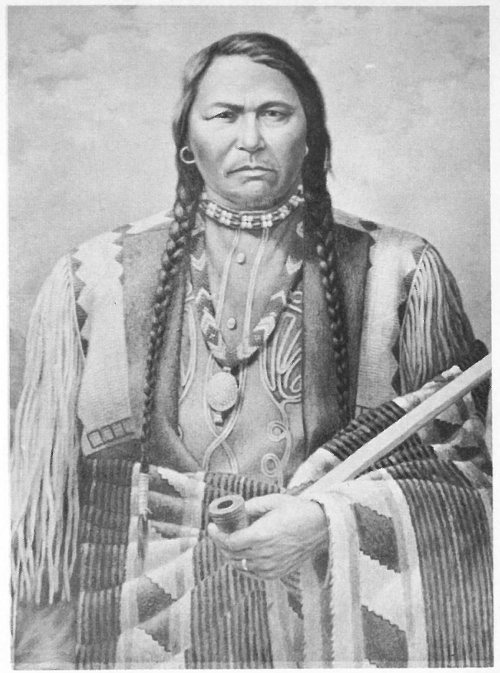
Chief Ouray
Painting by Robert Lindneux
May 4, 1864. Transferred last month to the 1st Colorado Cavalry, which means I’ll be hitting the dust trail for summer encampment in a few days. Well, it’ll beat pushing a pen around in that stuffy orderly room or being stable nurse to a bunch of horses.
May 6, 1864. Bunch of the boys went over to Posthoff’s last evening for a last blow before leaving the post for the summer. The sutler’s store may have about all a soldier needs in the way of underwear, boots, saddle soap, and the rest, but it stocks no whiskey. Posthoff’s store, being off the reservation proper, takes care of this 10 shortage for us. Posthoff stocks about everything needed in these parts by the civilians too, of course. But last night we tried to drink old Posthoff out of liquor—and almost did. About every man in the 1st Cavalry was there, with pretty Mexican and Indian girls bringing in food and filling our cups. All day long a company of horse soldiers have been sorry they kept such late hours. The smell of dust and saddle leather has done a lot for our thirst, but little for our appetites. It’s days like this that make me wonder if the $17 a sergeant gets each month is worth it.

Sunday Morning Barrack’s Inspection.
In Camp, June 2, 1864. Spending a little time now camped in Antelope Park. Camp life isn’t bad; just as many bugles blown during the day as at the fort and just as much work, but a tent’s easier to keep clean than a barrack. Indians here about seem restless. Patrols sent out regularly to keep a check on them.
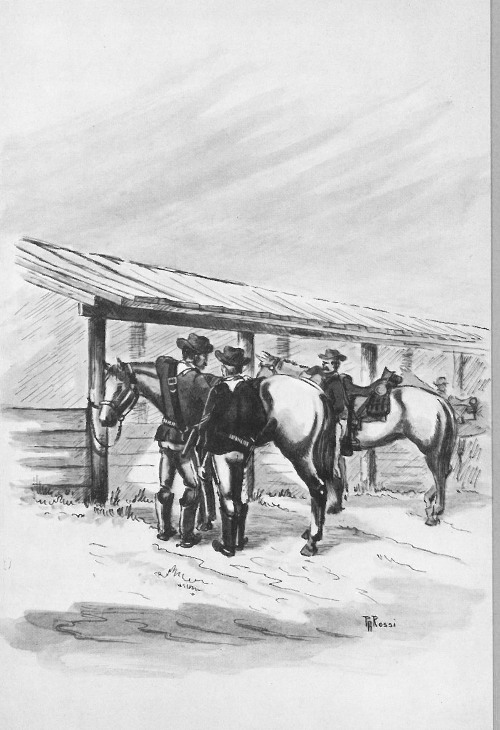
Cavalry Troops Preparing for March.
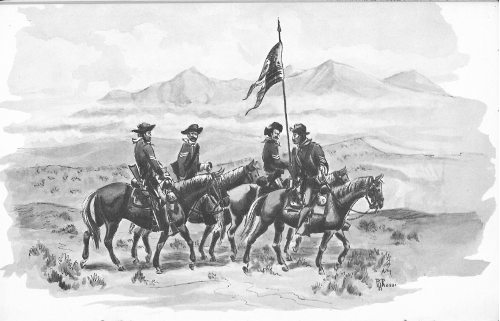
A Scouting Detail Returning to the Fort.
Fort Garland, November 21, 1864. Back at the fort life goes on about as before. Nights are getting cold. We sit inside evenings now next to fires of piñon logs. Some spend the hours playing cards, others read or study, and some form small groups and sing. The inside of the quarters look good after months in the open. The white walls and blue furniture and woodwork have come to mean home to me. The wooden beds, designed to sleep two, may be covered only with a straw tick, but it’s a lot softer than the ground. The food is better at the fort than in the field, of course. The hardtack and provisions carried on march leave something to be desired. The hardtack we’re getting must have been made by the Rebs. Even the hot coffee won’t soften it. Corporal White said the other night that once he found something soft inside a hardtack biscuit and when he looked to see what it was, he found that it was an old rifle ball. “Looked like the kind used during the War of 1812,” cracked White.

December 5, 1864. Just heard the news of Colonel Chivington wiping out a whole tribe of Indians at Sand Creek. If word gets back to any friends of those poor devils I’m thinking we’d better all start cleaning our carbines and looking for a hole to crawl into.
News from the East is that Lincoln has been re-elected. War seems about won by the Union forces. Things been going bad for Lee since Gettysburg.
May 4, 1865. Lee gives up at a place called Appomattox. Even the Texans have decided to quit. The boys here are looking to be sent home, since most are volunteers. Only a handfull of regulars like myself have been at the fort during these war years. Might take a leave myself or just give up being a soldier.
April 2, 1866. Back from leave. Brought a wife with me. Never thought of getting married, but while in Denver last winter I met Molly and first thing I knew she had me. We moved into the married quarters for non-coms over northeast of the general inclosure. Molly don’t seem to mind life at the fort, in spite of the fact that she, like all the other non-com wives, has to spend considerable time every week washing shirts and socks in the post laundry.
Being married throws a new light on life in the fort. People get together for parties and talk. The wives are more ambitious for the men than the men are for themselves. “When are you going to be promoted?” they all ask their husbands. What’s the difference if you’re making $13 as a private or $17 as a sergeant?
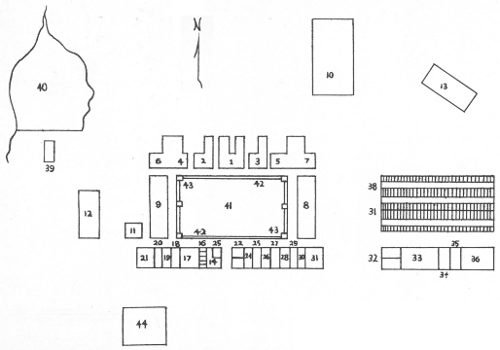
Ground Plan of Fort Garland.
Copy of the ground plan of Fort Garland, Colo., by 1st. Lt. J. W. Bean, 15th. Infantry, A.A.GM., November 17, 1877.
| 1 to 7 | Officers’ Qrs. |
| 8 | Cavalry Barracks |
| 9 | Infantry Barracks |
| 10 | Post Hospital |
| 11 | Inf. Co. Kitchen |
| 12 | Inf. Laundress Qrs. |
| 13 | Cav. Laundress Qrs. |
| 14 | Guard Room |
| 15 | Prisoners’ Room |
| 16 | Prisoners’ Cells |
| 17 | Grain Room |
| 18 | Shoemaker’s & Tailor’s Shop |
| 19 | Post Bakery |
| 20 | Stove Room |
| 21 | Lumber & Coal Room |
| 22 | Adjutant’s Office |
| 23 | Commanding Officer’s Office |
| 24 | Ordnance Store Room |
| 25 | Chapel & Lodge Room |
| 26 | Telegraph Office |
| 27 | Condemned Store Rm. |
| 28 | Cavalry Kitchen |
| 29 | Cav. Dining Room |
| 30 | Carpenter Shop |
| 31 | Blacksmith Shop |
| 32 | Qm. & Comsy. Off. |
| 33 | Subsistence Stores |
| 34 | Subsist. Issue Rm. |
| 35 | Clothing Room |
| 36 | Q.M. Store Room |
| 37 | Q.M. Corral |
| 38 | Cav. Stables |
| 39 | Ice House |
| 40 | Ice Pond |
| 41 | Parade Ground |
| 42 | Acequia |
| 43 | Water Boxes |
| 44 | Post Trader’s Store |
May 7, 1866. Colonel (and Brevet Brigadier General) Kit Carson is our new commander. He commanded a regiment of New Mexico Volunteers during the war and was sent on here with some of his old men. Good thing they sent a man like Colonel Carson to old Garland—those cantankerous Utes have been raising cane around the settlements for several months and seem to be getting worse. About the only reason they haven’t declared war on all of us is that one of their chiefs, called Uray or Ulay,[4] has been keeping them in harness.
June 28, 1866. Started building hospital northeast of parade. Adobes not baked properly—rain all the time. Building won’t stand for many seasons.
July 18, 1866. Our commander is a man to be respected. He’s keeping this Indian Pot from boiling in these parts by his will alone. The Utes are short on rations, some of them starving. They come to the fort and beg food almost every day. Maybe they’re not as hungry as they act, but they are hungry enough to be dangerous. Colonel Carson sends them away with what he can spare and has written to the Indian Agent for rations for the nearby tribes. The guard in the crow’s nest on the flag pole keeps a wary eye on the valley these nights. This fort has never been attacked, but the settlements about have been molested on several occasions.
September 12, 1866. Molly let me know that I’m to be a father come next spring. An old blue coat like myself a father! Good news comes in bunches; I was made Sergeant Major today, with a salary increase to $23. That should keep a family of five!
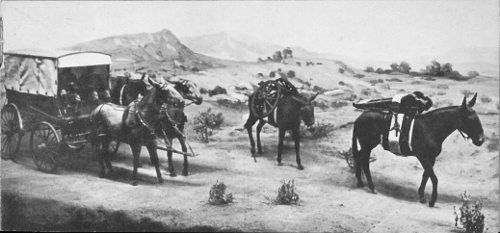
Army Escort Wagon. From diorama in Fort Museum.

“The Guard is Mounted, Sir.”
Sat watching Kit Carson, our commander, this evening. He stood alone on the parade grounds after retreat; the last soft sound of the bugle had died away and the troops had been dismissed. Carson stood looking up at that towering flag staff for about five minutes before he turned away. He looked uncomfortable in his uniform, as he always does. A more unmilitary man I’ve never known—and yet a better commander none of us would ever want. He makes up for his lack of book-learning with his knowledge of everything there is to know of hunting, trapping, Indian fighting and woods lore. He’s a short man, about five feet four, with legs so bowed he looks astride a horse even when he’s walking. Here at Garland, Colonel Carson has kept open house—open to all passersby (Indian and White) and even to soldiers and their wives. The wild tribe of children he brought with him are as untamed as the beasts of the mountains. One thing about it, though, when a dispute arises between Indians and settlers, the first to be called in is our “Kitty,” as the Utes call him. I’ve seen him sitting in the middle of them, laughing and joking in Spanish or Ute tongue, making hand movements for each word he speaks. Maybe it helps him to be understood.
September 23, 1866. We’ve had big doings round here. Lieutenant General W. T. Sherman, Governor (A.) Cumming, a whole patch of Ute chiefs and Kit Carson met to try to work out a treaty. This was to be a preliminary council afore the big one to be held on the banks of the Rio Grande, some thirty miles from here. On one side of the council room squatted the chiefs and on the other side sat Sherman, smoking a long cigar, with Kit on one side of him and the Governor on the other. Carson talked to the chiefs, he being the only one who could speak any language they could all understand. Kit urged the Utes to take to a reservation, as Sherman wanted them to do, but they didn’t like the idea. Chief Uray told Kit he knew he spoke for the Indian’s good, but that they couldn’t live so confined. Sherman gave up, finally, remarking that they’d have to freeze and starve a little bit more afore they’d listen to reason. The next council meeting gained only a little more. Governor Cumming did get the Tabequaches to agree to a treaty which permitted roads to be built through their lands. Chief Uray had signed another treaty in 1864. Uray even took a trip to Washington by stage and train and talked with President Lincoln. They say he came back and told his people that the Indians could never keep the white men out of their lands; that there were too many of them. Mighty smart Indian.

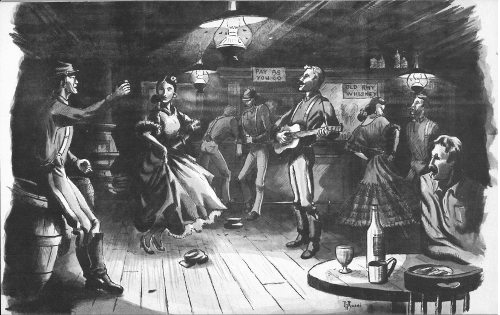
“Cups High! Tomorrow We March.”

October 10, 1866. Some of the Ute tribes have been on the warpath again. Chief Cuneatch[5] is angry with Uray for dealing with the Whites and has stirred up some of the other chiefs. A few settlers and some Indians have been killed. The post stands as a strong point in the Valley these days, but our commander, Colonel Carson, and his friend Chief Uray are our real strength. Carson has told all the Indians to camp near the fort and not go north for their presents this year. He has promised them food and presents if they stay and remain peaceful. Some of the young bucks will go to war, but Carson and Uray will keep the remainder of the Utes hobbled and staked.
October 28, 1866. Captain (A. J.) Alexander of the 3rd Cavalry and some of his men took care of Cuneatch’s band of trouble-makers. They rounded up most of them and brought them into the fort; had to kill a few of them, however, before they could get old Cuneatch to come. Colonel Carson wants to get some kind of agreement or treaty signed with this bunch of Utes before real trouble sets in.
April 25, 1868. Kit Carson is dead. He died on the 23rd, after his return from Washington. He and several Ute chiefs, including Chief Uray, went to Washington to confer on a treaty for the Ute or Utah Indians. The treaty was drawn-up, but hasn’t been ratified by Congress. But old Kit is dead! His last official act was to try to keep the peace.
July 17, 1868. My outfit is leaving Garland and this time I’ll be going along. I wonder when or if I’ll see the fort again? Meyer and Posthoff entertained the whole detachment last night with a farewell blow. Molly and our two little ones will have to follow me to the new post at a later date.
(The Valley was fairly peaceful during the years of Sgt. O’Connor’s absence. Life at the fort changed but little, as new companies of Infantry and Cavalry came and went.)
September 10, 1879. Back home again. Returned to Fort Garland last week after more’n ten years here, there and everywhere, with first one outfit and then another. A soldier’s life is a weary one. But it’s good to be back here where I really began soldiering. Let’s see now, been 19 years since I first came to Garland. The place has changed since the early days. Even got a railroad running by the fort—came in ’78. Two years earlier Colorado Territory was made the 38th State. New buildings have been added; all made of the same old adobe, of course. The parade is a little greener and the cottonwood trees have grown tall enough to make good shade. The barrack rooms are now heated with stoves as well as fireplaces and they’ve built a kitchen and mess to the southwest of the Infantry barrack. The soldiers’ quarters have a little more furniture and the officers’ quarters are a little more spick and span. More females about the place, too, now that the Valley is more civilized. The soldiers here are a lot younger than they used to be; lot of pink-faced boys who’ve never heard an Indian whoop.

The Fort’s West Barracks. Mount Blanca in the background. About 1900.

The Fort Abandoned. Officer’s Row, about 1900.
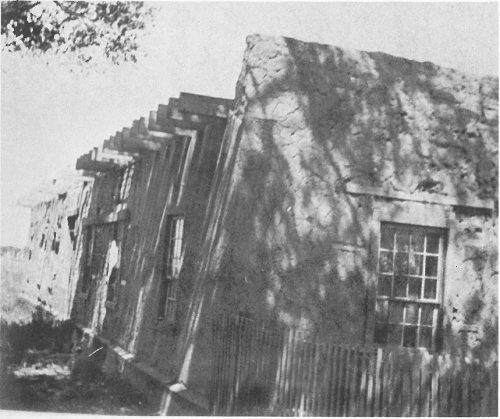
Fort Buildings in Ruins—just prior to restoration.

October 10, 1879. We just got news of the Indian uprising in Western Colorado. An Indian agent by the name of N. C. Meeker at the White River Agency was killed and some of his people killed or carried off. Major T. T. Thornburgh and his troops from Fort Steele, Wyoming, had been sent for before the affair began, but they didn’t arrive in time to save Meeker. Battle began on September 29th and took place somewhere between Beaver Creek and Milk River between Thornburgh’s men and a whole parcel of Utes under a chief named Jack. It’s said that Thornburgh had less than 150 men, mostly Cavalry, while the Utes numbered 300-400. A detachment of colored troops from Garland in on the affair, we’re told. Thornburgh made a defense and held off the Utes for several days, but the situation was pretty bad. By the 1st of October they got word to Rawlings, Wyoming and a General Merritt set out with about 350 men. On the morning of the 5th, after a 170 mile forced march, Merritt’s men arrived at the burned-over circle of wagons which marked the defender’s position. I know how Thornburgh’s men yelled when they saw that relief column that morning. I’ve set-up considerable howl myself on similar occasions. In cases like that you don’t care if the men coming to rescue you are Infantry or Cavalry, you’re that glad.
June 4, 1880. More troops coming into the fort every day. The fracas out at the White River Agency last year has caused considerable excitement, although the Indians around here have been fairly quiet. Chief Uray has done a lot to keep things peaceful in the valley. If he’d had his way about it, the Thornburgh affair wouldn’t have happened. The post and the town are bustling—they even got a hotel here now. It may not be much for comfort, but it’s something for these parts. If they don’t stop sending in new units and new men, some of us may be sleeping in worse places than the hotel.
September 1, 1880. Bad news came this week. Chief Uray or Ouray, as some call him, died on August 24. He’d been made big chief of the Utes and had held them pretty well in tow; hard to say what will happen now. More men coming into Garland. Most of the new-comers are living in tents.
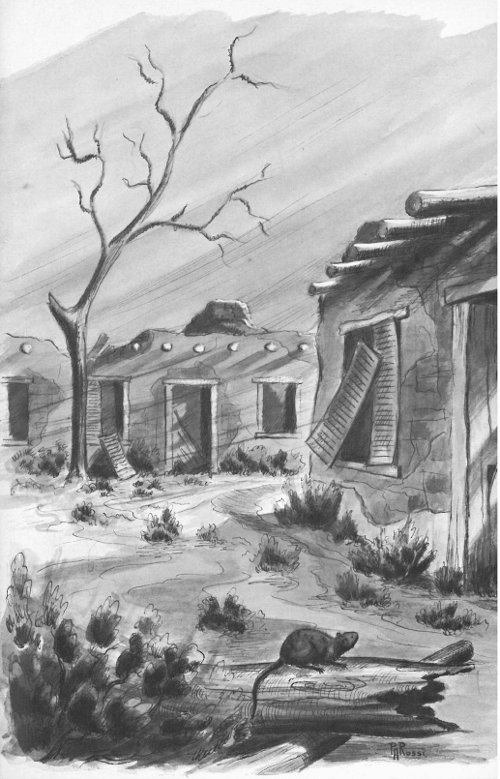
“Only a Memory....”
June 1, 1881. Colonel (Brevet Brigadier General) R. S. Mackenzie, in command of the troops stationed here at the fort, has set out for the Uncompahgre valley to prepare to move the Utes into Utah. Old Ouray is dead and the thing he never wanted to see is going to happen—his people will be moved to a reservation. Maybe it’s best for them.
October 1, 1881. The Utes had to be threatened by Mackenzie before they’d start the long hike into Utah, but when they found they had no choice they went quietly and mighty pronto. The Whites thereabout were, of course, happy to see them leave. Everyone realizes that this puts an end to any Indian menace in the State.
March 16, 1882. With the Indians gone, the old fort is back to normal and maybe short of normal. Last year we had as many as 1500 men here—now we’re down to a couple of companies. My boys are growing up, but by the time they’re soldier age it appears there won’t be any place for them to soldier.
July 4, 1882. Had a big Independence Day celebration here today. Not much else to celebrate. Inspection team came to the fort again this week and it looks as if they’re going to close up all the old forts and kick-out all the old soldiers. The company commander, a young buck, had the brass to tell me I was getting too old to soldier. This fort’s getting old too. They haven’t been keeping the adobe walls plastered with mud like they used to and the rains have been making little rivers down the sides of the buildings.
February 5, 1883. At the end of this enlistment—which comes up in December this year—they say I’ve got to retire. I’m not an old man, but several old wounds have been bothering me and the doctor turned in a bad report on me. Why! I won’t know what to do away from the Army and this old fort. They might as well shoot me like they do a horse that’s broken his leg.
October 10, 1883. Major General John Pope, commanding the Department of the Missouri, has recommended to the War Department that they close several Indian forts and Garland is one of them. Well, the old fort and the old soldier can go together.
November 29, 1883. Tomorrow the fort closes—likely forever. Company A, 22nd United States Infantry, under the command of Captain Javan Irvine, will leave here for Fort Lewis, Colorado, and no new company will come to replace it—as has happened for these past twenty-odd years. Somehow it won’t seem so bad to leave the Army now, knowing that Garland and I close our gates together. Family and I are going to stay on in the valley and try doing a little ranching. Got a whole flock of kids to help.
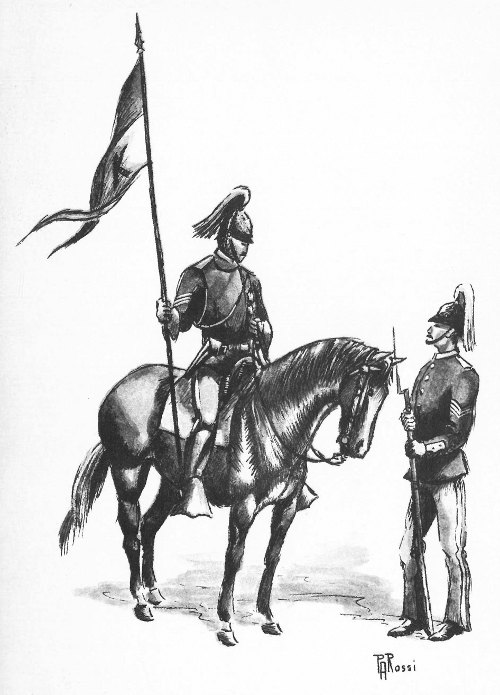
Cavalry and Infantry Sergeants in Full Dress.
By Rosamund Slack
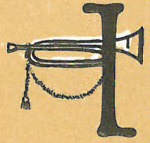
In 1883 Fort Garland was abandoned and the equipment belonging to the fort was sent to the new Fort Lewis, while the fort lands reverted to the Trinchera Estate. For many years stock wandered across the parade to nibble of the grass once trod by drilling soldiers—rats and other small animals inhabited the barracks and officer’s quarters. Decay and erosion set to work in earnest in an effort to destroy the old fort. It appeared that the once proud adobe walls would become a part of the soil again and that Fort Garland would be only a memory in the minds of a few old soldiers who had made the garrison their home.
In 1915 W. H. Meyer, a State senator, bought the property and used the commandant’s house for his home. One of the barracks became a barn. The Meyer home was altered soon afterwards, a gable roof and additional windows being added. Fortunately, Meyer was interested in history and in the fort. He tried to keep the remaining buildings in some kind of repair and never deliberately changed the appearance of any building to any extent other than the commandant’s quarters.
Senator Meyer died in 1925 and a group of interested citizens of the San Luis Valley formed the Fort Garland Historical Fair Association and purchased the fort, with the idea of preserving what remained and someday establishing a museum. Over 600 persons in the surrounding area supported this project. A small museum was begun in the commandant’s house and once again the fort heard the sound of many voices, and felt the tread of many feet.
After several years of vain effort to maintain the fort buildings, the Fort Garland Historical Fair Association decided the job was one that should be done by a larger institution. In 1945 the fort and its land were deeded to the State Historical Society of Colorado, for restoration and development as a State historical monument. For two years Curator Edgar C. McMechen and his staff at the Denver museum worked and planned for the restoration of the five remaining buildings at the fort. In 1947 the actual restoration was begun.
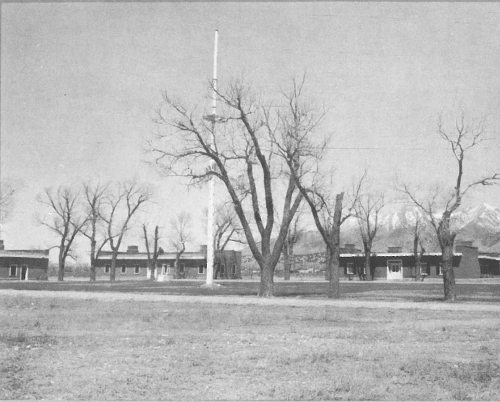
Fort Garland, After Restoration by the State.
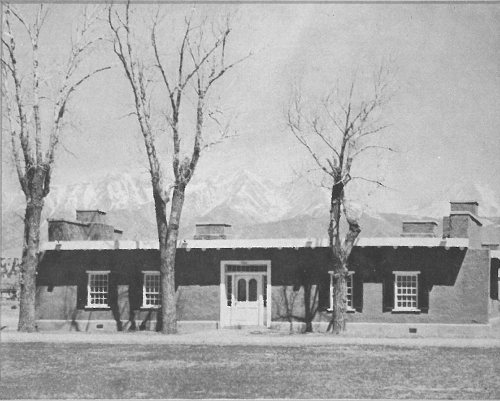
Mr. McMechen, a meticulous scholar, sought to reconstruct the fort as nearly as possible to its original appearance. He wished to use every original stone, every brick, every timber that was sound in the reconstructed buildings. The first step in the restoration was the removal of the old roofs which had, for the most part, collapsed or become unsound. The five buildings under construction were the west barracks, sometimes referred to as the Infantry barracks, the east, or Cavalry barracks, and three of the original five officer’s quarters along the north of the parade. The east barracks had suffered the most from lack of repair and deterioration. One wall had crumbled and fallen away and nothing remained of the roof but the cross beams. The buildings to the south had long since disappeared and while the Society planned to rebuild these two long structures, it found it impossible to undertake the task at that time. The two officers’ quarters located immediately to the right and left of the commandant’s building had also vanished and were not to be rebuilt.
The reconstruction work on the fort buildings required careful supervision. The adobe bricks were made as they were made in 1858—the mud being molded in forms and placed in the sun to bake. After the adobes were set in place, the walls were plastered inside and out with a coat of the same adobe material. Mexican women were employed to work the mud into the crevices and give the walls a smooth surface. This they did with their hands, alone, just as it has been done in the Southwest United States for centuries.
Plans for the fort museum called for the following: the commanding officers’ quarters, where Colonel Kit Carson commanded in 1866-67, to be restored as nearly as possible as it was when the famous scout resided there, with deer and antelope heads on the walls and the skins of animals covering the floor; one of the officer’s quarters to be used for a resident curator and not to be open to the public; the Cavalry barracks to be utilized as a period museum, to represent the history of the San Luis Valley from the days of the Spanish Conquest to pioneer settlement; the Infantry barracks to contain a typical squad room and the old soldier’s theatre. The painted backdrop on the wall of the theatre was still visible prior to restoration and the simple mural was to be restored. At some later date the two buildings to the south of the parade, on either side of the port sally, were to be rebuilt and would include the commandant’s and adjutant’s offices, the guard room, prisoners’ cells, post blacksmith shop, the post bakery and the post chapel. These rooms would all be furnished and equipped in the manner of the fort’s original service buildings.
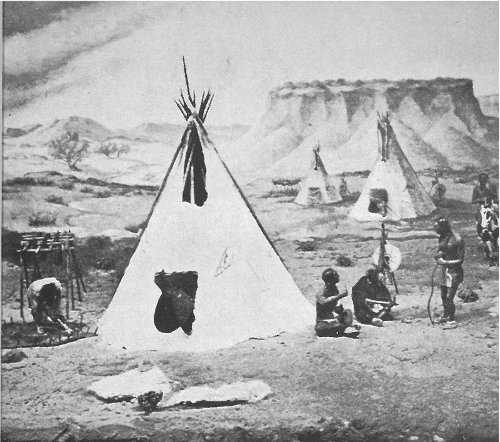
Ute Indian Village. Diorama in Fort Museum.
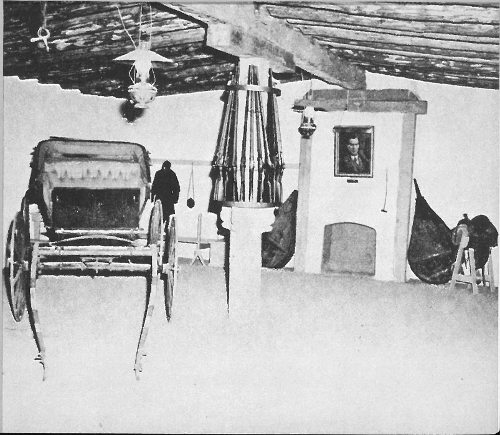
Interior of One of the Reconstructed Fort Buildings.
The Fort Garland Museum is an attempt to preserve in all its many aspects, military life at a frontier post in the 1860’s-70’s. The museum is also a store-house for the history of the southern portion of the State of Colorado. Many methods have been utilized to depict and present the colorful and exciting history of this area. In the west barrack, several dioramas illustrate in miniature scenes of: the Spanish Conquest, a Ute Indian camp, fur trading, a Mexican village, an Army escort wagon, a mule pack train and ambulance, and a stage coach robbery. Glass cases house a large collection of both military and pioneer materials. Period rooms, using life size manikins dressed in authentic costumes, will be placed in appropriate room settings, i.e., Kit Carson in conference with his aides and Chief Ouray.
In September of 1950 the reconstructed Fort Garland was dedicated with an impressive ceremony. Dr. James Grafton Rogers, president of the Society, gave the dedicatory address. Hundreds of persons from the surrounding area were on hand to see a long time dream of the region come to fruition.
The State of Colorado is indebted to a great number of people in the San Luis Valley, in particular, for their aid in bringing Fort Garland into being as a State monument, but the list would be too long to enter here. The State Historical Society is especially appreciative of the aid given and interest show by members of the Fort Garland Historical Fair Association, the Territorial Daughters and the Regional Committee on Fort Garland.
Mrs. Rosamund Slack assumed curatorship of Fort Garland in 1950, after the death of her husband, James Slack, who had been the curator.
PRINTED BY PEERLESS PRINTING CO.
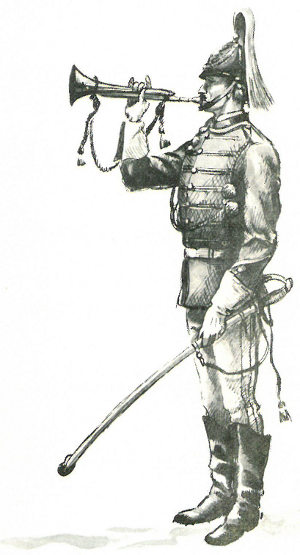
The exhibits for the Fort Garland buildings were prepared by members of the State Historical Society’s staff, which included: Roy Hunt, H. R. Antle, Paul Rossi, Juan Menchaca, Mervin King, the late Curator Edgar C. McMechen and James T. Forrest, who became Deputy Curator in charge of the Colorado State Museums in 1953.
End of the Project Gutenberg EBook of Old Fort Garland, by
James T. Forrest and Rosamund Slack
*** END OF THIS PROJECT GUTENBERG EBOOK OLD FORT GARLAND ***
***** This file should be named 47492-h.htm or 47492-h.zip *****
This and all associated files of various formats will be found in:
http://www.gutenberg.org/4/7/4/9/47492/
Produced by Stephen Hutcheson, Dave Morgan and the Online
Distributed Proofreading Team at http://www.pgdp.net
Updated editions will replace the previous one--the old editions will
be renamed.
Creating the works from print editions not protected by U.S. copyright
law means that no one owns a United States copyright in these works,
so the Foundation (and you!) can copy and distribute it in the United
States without permission and without paying copyright
royalties. Special rules, set forth in the General Terms of Use part
of this license, apply to copying and distributing Project
Gutenberg-tm electronic works to protect the PROJECT GUTENBERG-tm
concept and trademark. Project Gutenberg is a registered trademark,
and may not be used if you charge for the eBooks, unless you receive
specific permission. If you do not charge anything for copies of this
eBook, complying with the rules is very easy. You may use this eBook
for nearly any purpose such as creation of derivative works, reports,
performances and research. They may be modified and printed and given
away--you may do practically ANYTHING in the United States with eBooks
not protected by U.S. copyright law. Redistribution is subject to the
trademark license, especially commercial redistribution.
START: FULL LICENSE
THE FULL PROJECT GUTENBERG LICENSE
PLEASE READ THIS BEFORE YOU DISTRIBUTE OR USE THIS WORK
To protect the Project Gutenberg-tm mission of promoting the free
distribution of electronic works, by using or distributing this work
(or any other work associated in any way with the phrase "Project
Gutenberg"), you agree to comply with all the terms of the Full
Project Gutenberg-tm License available with this file or online at
www.gutenberg.org/license.
Section 1. General Terms of Use and Redistributing Project
Gutenberg-tm electronic works
1.A. By reading or using any part of this Project Gutenberg-tm
electronic work, you indicate that you have read, understand, agree to
and accept all the terms of this license and intellectual property
(trademark/copyright) agreement. If you do not agree to abide by all
the terms of this agreement, you must cease using and return or
destroy all copies of Project Gutenberg-tm electronic works in your
possession. If you paid a fee for obtaining a copy of or access to a
Project Gutenberg-tm electronic work and you do not agree to be bound
by the terms of this agreement, you may obtain a refund from the
person or entity to whom you paid the fee as set forth in paragraph
1.E.8.
1.B. "Project Gutenberg" is a registered trademark. It may only be
used on or associated in any way with an electronic work by people who
agree to be bound by the terms of this agreement. There are a few
things that you can do with most Project Gutenberg-tm electronic works
even without complying with the full terms of this agreement. See
paragraph 1.C below. There are a lot of things you can do with Project
Gutenberg-tm electronic works if you follow the terms of this
agreement and help preserve free future access to Project Gutenberg-tm
electronic works. See paragraph 1.E below.
1.C. The Project Gutenberg Literary Archive Foundation ("the
Foundation" or PGLAF), owns a compilation copyright in the collection
of Project Gutenberg-tm electronic works. Nearly all the individual
works in the collection are in the public domain in the United
States. If an individual work is unprotected by copyright law in the
United States and you are located in the United States, we do not
claim a right to prevent you from copying, distributing, performing,
displaying or creating derivative works based on the work as long as
all references to Project Gutenberg are removed. Of course, we hope
that you will support the Project Gutenberg-tm mission of promoting
free access to electronic works by freely sharing Project Gutenberg-tm
works in compliance with the terms of this agreement for keeping the
Project Gutenberg-tm name associated with the work. You can easily
comply with the terms of this agreement by keeping this work in the
same format with its attached full Project Gutenberg-tm License when
you share it without charge with others.
1.D. The copyright laws of the place where you are located also govern
what you can do with this work. Copyright laws in most countries are
in a constant state of change. If you are outside the United States,
check the laws of your country in addition to the terms of this
agreement before downloading, copying, displaying, performing,
distributing or creating derivative works based on this work or any
other Project Gutenberg-tm work. The Foundation makes no
representations concerning the copyright status of any work in any
country outside the United States.
1.E. Unless you have removed all references to Project Gutenberg:
1.E.1. The following sentence, with active links to, or other
immediate access to, the full Project Gutenberg-tm License must appear
prominently whenever any copy of a Project Gutenberg-tm work (any work
on which the phrase "Project Gutenberg" appears, or with which the
phrase "Project Gutenberg" is associated) is accessed, displayed,
performed, viewed, copied or distributed:
This eBook is for the use of anyone anywhere in the United States and
most other parts of the world at no cost and with almost no
restrictions whatsoever. You may copy it, give it away or re-use it
under the terms of the Project Gutenberg License included with this
eBook or online at www.gutenberg.org. If you are not located in the
United States, you'll have to check the laws of the country where you
are located before using this ebook.
1.E.2. If an individual Project Gutenberg-tm electronic work is
derived from texts not protected by U.S. copyright law (does not
contain a notice indicating that it is posted with permission of the
copyright holder), the work can be copied and distributed to anyone in
the United States without paying any fees or charges. If you are
redistributing or providing access to a work with the phrase "Project
Gutenberg" associated with or appearing on the work, you must comply
either with the requirements of paragraphs 1.E.1 through 1.E.7 or
obtain permission for the use of the work and the Project Gutenberg-tm
trademark as set forth in paragraphs 1.E.8 or 1.E.9.
1.E.3. If an individual Project Gutenberg-tm electronic work is posted
with the permission of the copyright holder, your use and distribution
must comply with both paragraphs 1.E.1 through 1.E.7 and any
additional terms imposed by the copyright holder. Additional terms
will be linked to the Project Gutenberg-tm License for all works
posted with the permission of the copyright holder found at the
beginning of this work.
1.E.4. Do not unlink or detach or remove the full Project Gutenberg-tm
License terms from this work, or any files containing a part of this
work or any other work associated with Project Gutenberg-tm.
1.E.5. Do not copy, display, perform, distribute or redistribute this
electronic work, or any part of this electronic work, without
prominently displaying the sentence set forth in paragraph 1.E.1 with
active links or immediate access to the full terms of the Project
Gutenberg-tm License.
1.E.6. You may convert to and distribute this work in any binary,
compressed, marked up, nonproprietary or proprietary form, including
any word processing or hypertext form. However, if you provide access
to or distribute copies of a Project Gutenberg-tm work in a format
other than "Plain Vanilla ASCII" or other format used in the official
version posted on the official Project Gutenberg-tm web site
(www.gutenberg.org), you must, at no additional cost, fee or expense
to the user, provide a copy, a means of exporting a copy, or a means
of obtaining a copy upon request, of the work in its original "Plain
Vanilla ASCII" or other form. Any alternate format must include the
full Project Gutenberg-tm License as specified in paragraph 1.E.1.
1.E.7. Do not charge a fee for access to, viewing, displaying,
performing, copying or distributing any Project Gutenberg-tm works
unless you comply with paragraph 1.E.8 or 1.E.9.
1.E.8. You may charge a reasonable fee for copies of or providing
access to or distributing Project Gutenberg-tm electronic works
provided that
* You pay a royalty fee of 20% of the gross profits you derive from
the use of Project Gutenberg-tm works calculated using the method
you already use to calculate your applicable taxes. The fee is owed
to the owner of the Project Gutenberg-tm trademark, but he has
agreed to donate royalties under this paragraph to the Project
Gutenberg Literary Archive Foundation. Royalty payments must be paid
within 60 days following each date on which you prepare (or are
legally required to prepare) your periodic tax returns. Royalty
payments should be clearly marked as such and sent to the Project
Gutenberg Literary Archive Foundation at the address specified in
Section 4, "Information about donations to the Project Gutenberg
Literary Archive Foundation."
* You provide a full refund of any money paid by a user who notifies
you in writing (or by e-mail) within 30 days of receipt that s/he
does not agree to the terms of the full Project Gutenberg-tm
License. You must require such a user to return or destroy all
copies of the works possessed in a physical medium and discontinue
all use of and all access to other copies of Project Gutenberg-tm
works.
* You provide, in accordance with paragraph 1.F.3, a full refund of
any money paid for a work or a replacement copy, if a defect in the
electronic work is discovered and reported to you within 90 days of
receipt of the work.
* You comply with all other terms of this agreement for free
distribution of Project Gutenberg-tm works.
1.E.9. If you wish to charge a fee or distribute a Project
Gutenberg-tm electronic work or group of works on different terms than
are set forth in this agreement, you must obtain permission in writing
from both the Project Gutenberg Literary Archive Foundation and The
Project Gutenberg Trademark LLC, the owner of the Project Gutenberg-tm
trademark. Contact the Foundation as set forth in Section 3 below.
1.F.
1.F.1. Project Gutenberg volunteers and employees expend considerable
effort to identify, do copyright research on, transcribe and proofread
works not protected by U.S. copyright law in creating the Project
Gutenberg-tm collection. Despite these efforts, Project Gutenberg-tm
electronic works, and the medium on which they may be stored, may
contain "Defects," such as, but not limited to, incomplete, inaccurate
or corrupt data, transcription errors, a copyright or other
intellectual property infringement, a defective or damaged disk or
other medium, a computer virus, or computer codes that damage or
cannot be read by your equipment.
1.F.2. LIMITED WARRANTY, DISCLAIMER OF DAMAGES - Except for the "Right
of Replacement or Refund" described in paragraph 1.F.3, the Project
Gutenberg Literary Archive Foundation, the owner of the Project
Gutenberg-tm trademark, and any other party distributing a Project
Gutenberg-tm electronic work under this agreement, disclaim all
liability to you for damages, costs and expenses, including legal
fees. YOU AGREE THAT YOU HAVE NO REMEDIES FOR NEGLIGENCE, STRICT
LIABILITY, BREACH OF WARRANTY OR BREACH OF CONTRACT EXCEPT THOSE
PROVIDED IN PARAGRAPH 1.F.3. YOU AGREE THAT THE FOUNDATION, THE
TRADEMARK OWNER, AND ANY DISTRIBUTOR UNDER THIS AGREEMENT WILL NOT BE
LIABLE TO YOU FOR ACTUAL, DIRECT, INDIRECT, CONSEQUENTIAL, PUNITIVE OR
INCIDENTAL DAMAGES EVEN IF YOU GIVE NOTICE OF THE POSSIBILITY OF SUCH
DAMAGE.
1.F.3. LIMITED RIGHT OF REPLACEMENT OR REFUND - If you discover a
defect in this electronic work within 90 days of receiving it, you can
receive a refund of the money (if any) you paid for it by sending a
written explanation to the person you received the work from. If you
received the work on a physical medium, you must return the medium
with your written explanation. The person or entity that provided you
with the defective work may elect to provide a replacement copy in
lieu of a refund. If you received the work electronically, the person
or entity providing it to you may choose to give you a second
opportunity to receive the work electronically in lieu of a refund. If
the second copy is also defective, you may demand a refund in writing
without further opportunities to fix the problem.
1.F.4. Except for the limited right of replacement or refund set forth
in paragraph 1.F.3, this work is provided to you 'AS-IS', WITH NO
OTHER WARRANTIES OF ANY KIND, EXPRESS OR IMPLIED, INCLUDING BUT NOT
LIMITED TO WARRANTIES OF MERCHANTABILITY OR FITNESS FOR ANY PURPOSE.
1.F.5. Some states do not allow disclaimers of certain implied
warranties or the exclusion or limitation of certain types of
damages. If any disclaimer or limitation set forth in this agreement
violates the law of the state applicable to this agreement, the
agreement shall be interpreted to make the maximum disclaimer or
limitation permitted by the applicable state law. The invalidity or
unenforceability of any provision of this agreement shall not void the
remaining provisions.
1.F.6. INDEMNITY - You agree to indemnify and hold the Foundation, the
trademark owner, any agent or employee of the Foundation, anyone
providing copies of Project Gutenberg-tm electronic works in
accordance with this agreement, and any volunteers associated with the
production, promotion and distribution of Project Gutenberg-tm
electronic works, harmless from all liability, costs and expenses,
including legal fees, that arise directly or indirectly from any of
the following which you do or cause to occur: (a) distribution of this
or any Project Gutenberg-tm work, (b) alteration, modification, or
additions or deletions to any Project Gutenberg-tm work, and (c) any
Defect you cause.
Section 2. Information about the Mission of Project Gutenberg-tm
Project Gutenberg-tm is synonymous with the free distribution of
electronic works in formats readable by the widest variety of
computers including obsolete, old, middle-aged and new computers. It
exists because of the efforts of hundreds of volunteers and donations
from people in all walks of life.
Volunteers and financial support to provide volunteers with the
assistance they need are critical to reaching Project Gutenberg-tm's
goals and ensuring that the Project Gutenberg-tm collection will
remain freely available for generations to come. In 2001, the Project
Gutenberg Literary Archive Foundation was created to provide a secure
and permanent future for Project Gutenberg-tm and future
generations. To learn more about the Project Gutenberg Literary
Archive Foundation and how your efforts and donations can help, see
Sections 3 and 4 and the Foundation information page at
www.gutenberg.org
Section 3. Information about the Project Gutenberg Literary Archive Foundation
The Project Gutenberg Literary Archive Foundation is a non profit
501(c)(3) educational corporation organized under the laws of the
state of Mississippi and granted tax exempt status by the Internal
Revenue Service. The Foundation's EIN or federal tax identification
number is 64-6221541. Contributions to the Project Gutenberg Literary
Archive Foundation are tax deductible to the full extent permitted by
U.S. federal laws and your state's laws.
The Foundation's principal office is in Fairbanks, Alaska, with the
mailing address: PO Box 750175, Fairbanks, AK 99775, but its
volunteers and employees are scattered throughout numerous
locations. Its business office is located at 809 North 1500 West, Salt
Lake City, UT 84116, (801) 596-1887. Email contact links and up to
date contact information can be found at the Foundation's web site and
official page at www.gutenberg.org/contact
For additional contact information:
Dr. Gregory B. Newby
Chief Executive and Director
gbnewby@pglaf.org
Section 4. Information about Donations to the Project Gutenberg
Literary Archive Foundation
Project Gutenberg-tm depends upon and cannot survive without wide
spread public support and donations to carry out its mission of
increasing the number of public domain and licensed works that can be
freely distributed in machine readable form accessible by the widest
array of equipment including outdated equipment. Many small donations
($1 to $5,000) are particularly important to maintaining tax exempt
status with the IRS.
The Foundation is committed to complying with the laws regulating
charities and charitable donations in all 50 states of the United
States. Compliance requirements are not uniform and it takes a
considerable effort, much paperwork and many fees to meet and keep up
with these requirements. We do not solicit donations in locations
where we have not received written confirmation of compliance. To SEND
DONATIONS or determine the status of compliance for any particular
state visit www.gutenberg.org/donate
While we cannot and do not solicit contributions from states where we
have not met the solicitation requirements, we know of no prohibition
against accepting unsolicited donations from donors in such states who
approach us with offers to donate.
International donations are gratefully accepted, but we cannot make
any statements concerning tax treatment of donations received from
outside the United States. U.S. laws alone swamp our small staff.
Please check the Project Gutenberg Web pages for current donation
methods and addresses. Donations are accepted in a number of other
ways including checks, online payments and credit card donations. To
donate, please visit: www.gutenberg.org/donate
Section 5. General Information About Project Gutenberg-tm electronic works.
Professor Michael S. Hart was the originator of the Project
Gutenberg-tm concept of a library of electronic works that could be
freely shared with anyone. For forty years, he produced and
distributed Project Gutenberg-tm eBooks with only a loose network of
volunteer support.
Project Gutenberg-tm eBooks are often created from several printed
editions, all of which are confirmed as not protected by copyright in
the U.S. unless a copyright notice is included. Thus, we do not
necessarily keep eBooks in compliance with any particular paper
edition.
Most people start at our Web site which has the main PG search
facility: www.gutenberg.org
This Web site includes information about Project Gutenberg-tm,
including how to make donations to the Project Gutenberg Literary
Archive Foundation, how to help produce our new eBooks, and how to
subscribe to our email newsletter to hear about new eBooks.